[TOC]
1、计算机网络概念
1、什么是计算机网络?
计算机网络是指将==地理位置不同==的具有独立功能的==多台计算机及其外部设备,通过通信线路连接(有线性、无线)起来==,在网络操作系统,网络管理软件及==网络通信协议==的管理和协调下,实现==资源共享==和==信息传递==的计算机系统。
类比:信件
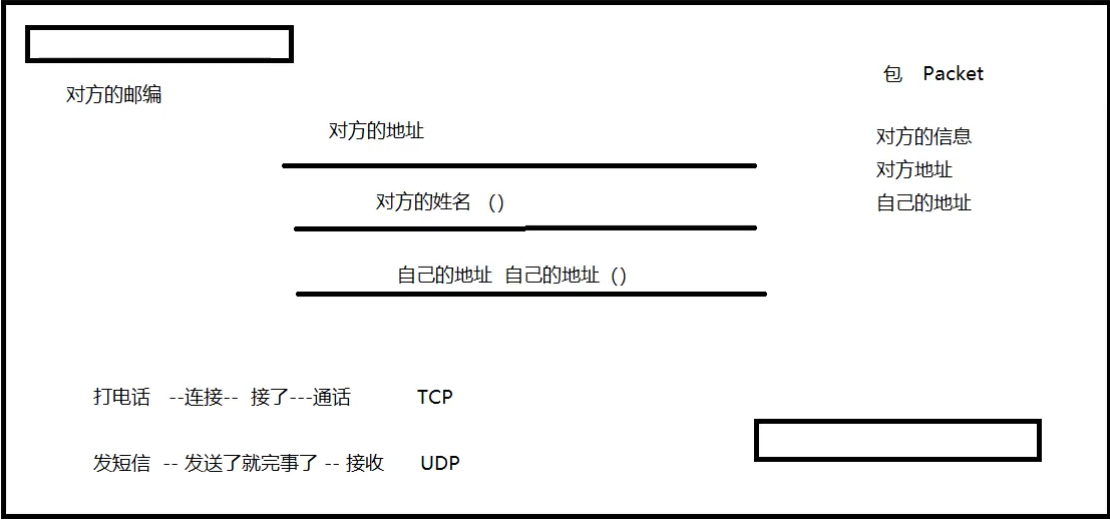
2、网络编程的目的
3、想要达到这个效果,需要什么
- 如何==准确的定位网络上的一台主机== 192.168.1.100: 端口,定位到这个计算机上的某个资源。
- 找到了这个主机,如何传输数据呢?
JavaWeb : 网页编程 B/S架构
网络编程: TCP/IP C/S架构
4、网络通信要素
如何实现网络的通信?
- ==通信双方的地址==:
- ==规则:网络通信的协议==
5、TCP/IP参考模型
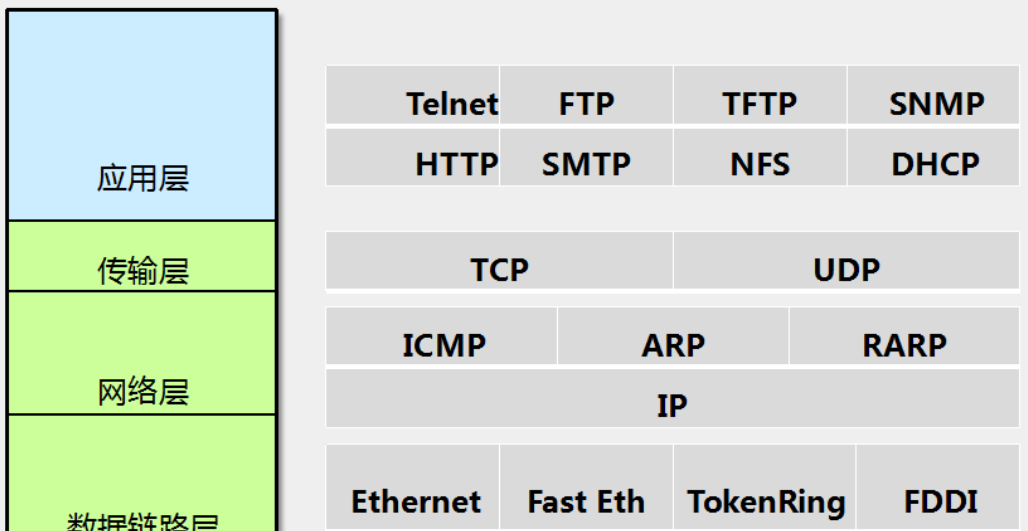
6、OSI七层参考模型 与 TCP/IP参考模型
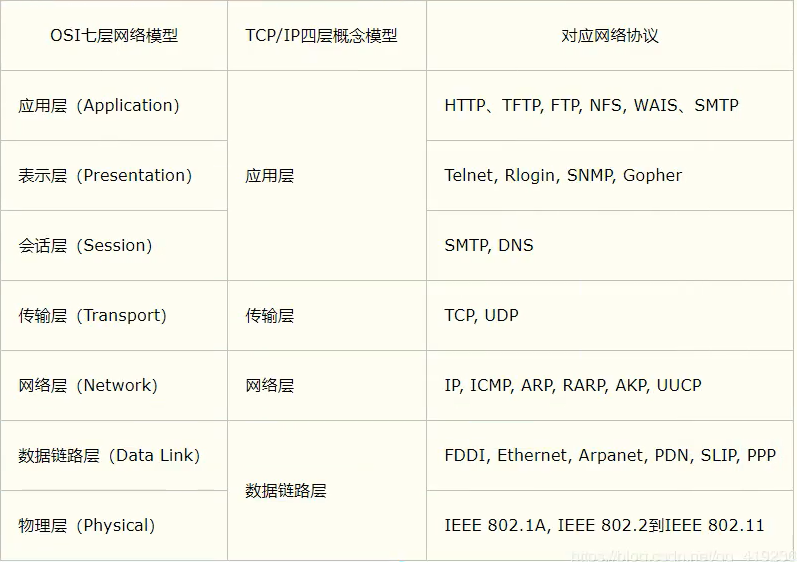
7、小结
- 网络编程中两个主要问题
- 如何准确定位到网络上的一台或多台主机
- 找到主机之后如何进行通信
- 网络编程中的要素
- Java 万物皆对象
2、IP——InetAddress
ip地址:InetAddress
- ==唯一定位一台网络上计算机==
- ==127.0.0.1: 本机localhost==
- ip地址的分类:IPV4/IPv6
- IPV4 127.0.0.1 4个字节组成,0-255 42亿个 30亿都在北美,亚洲4亿。2011年就用尽
- IPV6 ;128位。8个无符号整数!
- 公网-私网
测试代码
1
2
3
4
5
6
7
8
9
10
11
12
13
14
15
16
17
18
19
20
21
22
23
24
25
26
27
28
29
30
| package cn.bloghut.lesson01;
import java.net.InetAddress;
import java.net.UnknownHostException;
public class TestInetAddress {
public static void main(String[] args) throws Exception {
InetAddress localhost = InetAddress.getByName("localhost");
System.out.println(localhost);
InetAddress localHost = InetAddress.getLocalHost();
System.out.println(localHost);
System.out.println("=================");
InetAddress name = InetAddress.getByName("www.baidu.com");
System.out.println(name);
System.out.println("=================");
System.out.println(name.getHostAddress());
System.out.println(name.getHostName());
System.out.println(name.getCanonicalHostName());
}
}
|
3、端口——InetSocketAddress
==端口表示计算机上的一个程序的进程。==
- 一栋楼表示一个ip ,这栋楼里面的 门牌号 就是端口号。
- ==不同的进程有不同的端口号==!用来区分软件的。
- 端口被规定为:0-65535
- TCP ,UDP: 每个都有 0-65535 * 2 ,单个协议下,端口号不能冲突。
- 端口分类
- 公有端口:0-1023
- HTTP : 80
- HTTPS :443
- FTP : 21
- Telnet: 23
- 程序注册端口:1024-49151,分配给用户或者程序
- Tomcat:8080
- Mysql:3306
- Oracle:1521
- 动态、私有:49152-65535
1
2
3
4
| netstat -ano
netstat -ano | findstr "5900"
tasklist | findstr "8696"
Ctrl + Shift + ESC
|
相关代码
1
2
3
4
5
6
7
8
9
10
11
12
13
14
15
16
17
18
19
20
21
22
23
24
25
26
| package cn.bloghut.lesson01;
import java.net.InetSocketAddress;
public class TesyInetSocketAddress {
public static void main(String[] args) {
InetSocketAddress socketAddress = new InetSocketAddress("127.0.0.1", 8080);
InetSocketAddress socketAddress1 = new InetSocketAddress("localhost", 8080);
System.out.println(socketAddress);
System.out.println(socketAddress1);
System.out.println("====================");
System.out.println(socketAddress.getAddress());
System.out.println(socketAddress.getHostName());
System.out.println(socketAddress.getHostString());
System.out.println(socketAddress.getPort());
}
}
|
4、通信协议
协议:约定,就好比我们现在说的是普通话。
网络通信协议:
- 速率
- 传输码率
- 代码结构
- 传输控制
问题:非常的复杂
TCP/IP协议簇:实际上是一组协议
重要:
出名的协议:
- TCP
- IP
TCP和UDP 对比:
- TCP:打电话
- 连接: 稳定
- 三次握手
- 四次挥手
- A:我要断开了 (我要走了)
- B:我知道你要断开了(你真的要走了吗?)
- B:你真的断开了吗?(你真的真的要走了吗?)
- A:我真的断开了 (我真的要走了)
客户端,服务端
传输完成,释放连接、效率低
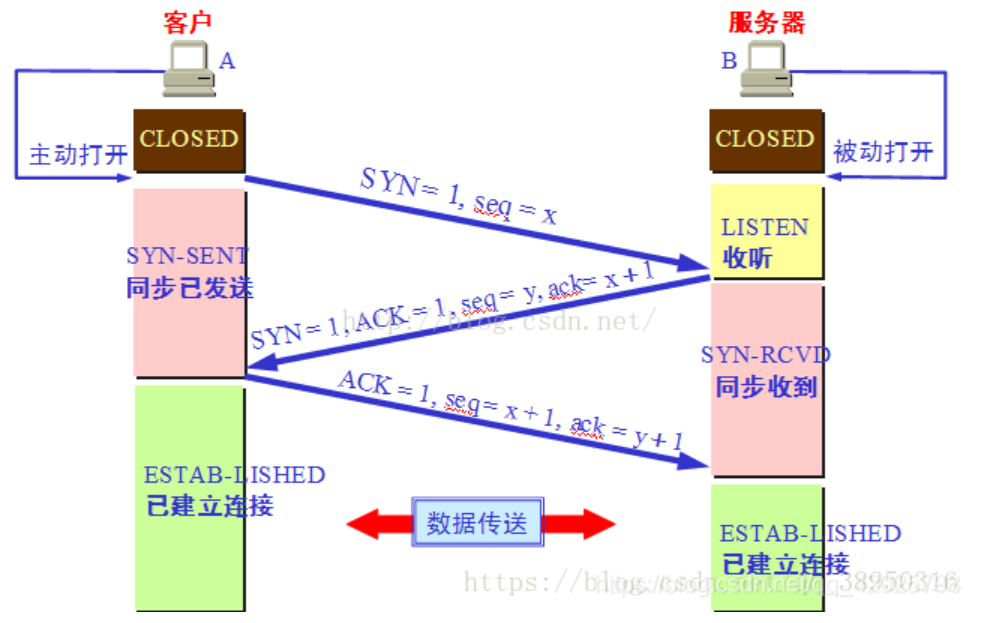
1、三次握手
- 第一次握手:建立连接时,客户端发送syn包(syn=j)到服务器,并进入SYN_SENT状态,等待服务器确认;SYN:同步序列编号(Synchronize Sequence Numbers)。
- 第二次握手:服务器收到syn包,必须确认客户的SYN(ack=j+1),同时自己也发送一个SYN包(syn=k),即SYN+ACK包,此时服务器进入SYN_RECV状态;
- 第三次握手:客户端收到服务器的SYN+ACK包,向服务器发送确认包ACK(ack=k+1),此包发送完毕,客户端和服务器进入ESTABLISHED(TCP连接成功)状态,完成三次握手。
2、四次挥手
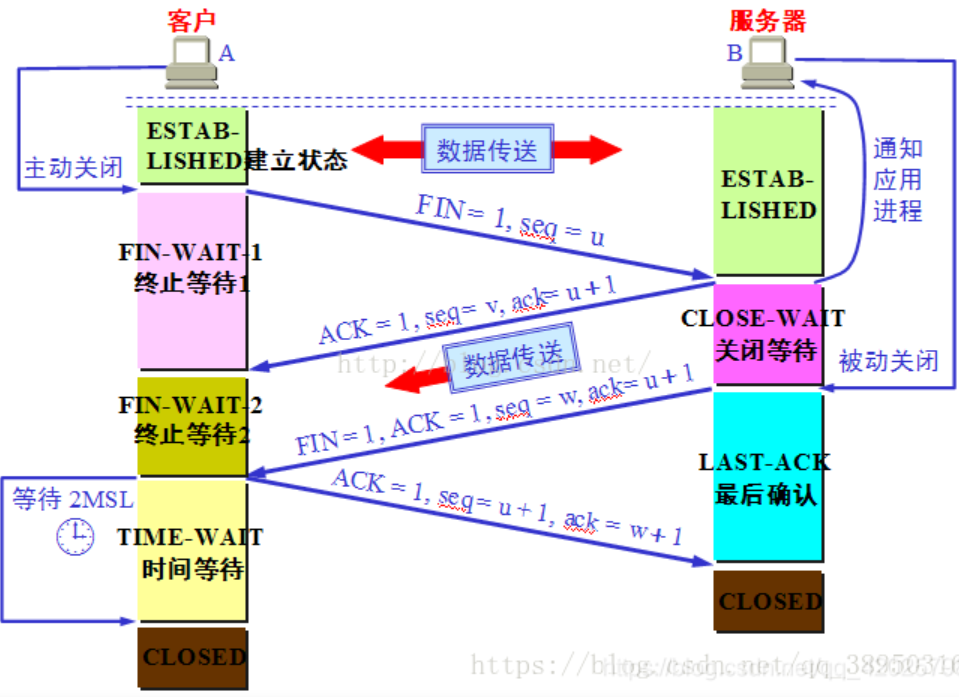
UDP:发短信
- 不连接,不稳定
- 客户端、服务端:没有明确的界限
- 不管有没有准备好,都可以发给你…
- 导弹
- DDOS:洪水攻击!(饱和攻击)
3、客户端
- 建立连接
- 发送消息
1
2
3
4
5
6
7
8
9
10
11
12
13
14
15
16
17
18
19
20
21
22
23
24
25
26
27
28
29
30
31
32
33
34
35
36
| package cn.bloghut.lesson02;
import java.io.IOException;
import java.io.OutputStream;
import java.net.InetAddress;
import java.net.Socket;
public class TcpClientDemo1 {
public static void main(String[] args) throws Exception{
Socket socket = null;
OutputStream os = null;
try {
InetAddress serverIp = InetAddress.getByName("localhost");
int port = 9999;
socket = new Socket(serverIp,port);
os = socket.getOutputStream();
os.write("你好,世界".getBytes());
} catch (IOException e) {
e.printStackTrace();
}finally {
if (os != null) {
os.close();
}
if (socket != null) {
socket.close();
}
}
}
}
|
4、服务器
- 建立服务连接的端口 ServerSocket
- 等待用户的连接 accept
- 接收用户信息
1
2
3
4
5
6
7
8
9
10
11
12
13
14
15
16
17
18
19
20
21
22
23
24
25
26
27
28
29
30
31
32
33
34
35
36
37
38
39
40
41
42
43
44
45
46
47
48
49
50
51
52
53
54
55
56
57
58
59
60
61
62
| package cn.bloghut.lesson02;
import java.io.ByteArrayInputStream;
import java.io.ByteArrayOutputStream;
import java.io.IOException;
import java.io.InputStream;
import java.net.ServerSocket;
import java.net.Socket;
public class TcpServerDemo01 {
public static void main(String[] args) throws Exception {
ServerSocket serverSocket = null;
Socket accept = null;
InputStream is = null;
ByteArrayOutputStream baos = null;
try {
serverSocket = new ServerSocket(9999);
accept = serverSocket.accept();
is = accept.getInputStream();
baos = new ByteArrayOutputStream();
byte[] buff = new byte[1024];
int len = -1;
while ((len = is.read(buff)) != -1) {
baos.write(buff, 0, len);
}
System.out.println(baos.toString());
} catch (IOException e) {
e.printStackTrace();
} finally {
if (baos != null) {
baos.close();
}
if (is != null) {
is.close();
}
if (accept != null) {
accept.close();
}
if (serverSocket != null) {
serverSocket.close();
}
}
}
}
|
5、TCP实现文件上传
1、客户端
1
2
3
4
5
6
7
8
9
10
11
12
13
14
15
16
17
18
19
20
21
22
23
24
25
26
27
28
29
30
31
32
33
34
35
36
37
38
39
| package cn.bloghut.lesson02;
import java.io.File;
import java.io.FileOutputStream;
import java.io.InputStream;
import java.io.OutputStream;
import java.net.ServerSocket;
import java.net.Socket;
public class TcpServerDemo2 {
public static void main(String[] args) throws Exception{
ServerSocket serverSocket = new ServerSocket(9999);
Socket accept = serverSocket.accept();
InputStream is = accept.getInputStream();
FileOutputStream fos = new FileOutputStream(new File("receive.jpg"));
byte[] buff = new byte[1024];
int len;
while ((len = is.read(buff)) != -1){
fos.write(buff,0,len);
}
OutputStream os = accept.getOutputStream();
os.write("我接收完毕了,你可以断开了".getBytes());
fos.close();
is.close();
accept.close();
serverSocket.close();
}
}
|
2、服务端
1
2
3
4
5
6
7
8
9
10
11
12
13
14
15
16
17
18
19
20
21
22
23
24
25
26
27
28
29
30
31
32
33
34
35
36
37
38
39
40
41
42
43
44
45
46
47
| package cn.bloghut.lesson02;
import java.io.*;
import java.net.InetAddress;
import java.net.Socket;
import java.net.UnknownHostException;
public class TcpClientDemo2 {
public static void main(String[] args) throws Exception {
Socket socket = new Socket(InetAddress.getByName("127.0.0.1"), 9999);
OutputStream os = socket.getOutputStream();
FileInputStream is = new FileInputStream(new File("1.jpg"));
byte[] buff = new byte[1024];
int len;
while ((len = is.read(buff)) != -1) {
os.write(buff, 0, len);
}
socket.shutdownOutput();
InputStream inputStream = socket.getInputStream();
ByteArrayOutputStream bos = new ByteArrayOutputStream();
byte[] buff2 = new byte[1024];
int len2;
while ((len2 = inputStream.read(buff)) != -1) {
bos.write(buff2, 0, len2);
}
System.out.println(bos.toString());
bos.close();
inputStream.close();
is.close();
os.close();
socket.close();
}
}
|
6、UDP:发短信,需要IP地址
1、发送端:发送消息——DatagramPacket
1
2
3
4
5
6
7
8
9
10
11
12
13
14
15
16
17
18
19
20
21
22
23
24
25
| package cn.bloghut.lesson3;
import java.net.DatagramPacket;
import java.net.DatagramSocket;
import java.net.InetAddress;
public class UdpClientDemo1 {
public static void main(String[] args) throws Exception{
DatagramSocket socket = new DatagramSocket();
String msg = "你好啊,服务器";
InetAddress address = InetAddress.getByName("localhost");
int port = 9090;
DatagramPacket packet = new DatagramPacket(msg.getBytes(), 0, msg.getBytes().length, address, port);
socket.send(packet);
}
}
|
2、接收端:接收消息——DatagramSocket
1
2
3
4
5
6
7
8
9
10
11
12
13
14
15
16
17
18
19
20
21
22
23
24
25
26
| package cn.bloghut.lesson3;
import java.net.DatagramPacket;
import java.net.DatagramSocket;
import java.net.InetAddress;
import java.net.ServerSocket;
public class UdpServerDemo1 {
public static void main(String[] args) throws Exception{
DatagramSocket socket = new DatagramSocket(9090);
byte[] buff =new byte[1024];
DatagramPacket packet = new DatagramPacket(buff, 0, buff.length);
socket.receive(packet);
System.out.println(packet.getAddress());
System.out.println(new String(packet.getData(),0,packet.getData().length));
socket.close();
}
}
|
7、UDP 实现聊天实现
1、发送方
1
2
3
4
5
6
7
8
9
10
11
12
13
14
15
16
17
18
19
20
21
22
23
24
25
26
27
28
29
30
31
| package cn.bloghut.chat;
import java.io.BufferedReader;
import java.io.InputStreamReader;
import java.net.DatagramPacket;
import java.net.DatagramSocket;
import java.net.InetSocketAddress;
public class UdpSenderDemo01 {
public static void main(String[] args) throws Exception {
DatagramSocket socket = new DatagramSocket(8080);
while (true) {
BufferedReader reader = new BufferedReader(new InputStreamReader(System.in));
String data = reader.readLine();
byte[] datas = data.getBytes();
DatagramPacket packet = new DatagramPacket
(datas, 0,datas.length, new InetSocketAddress("localhost", 6666));
socket.send(packet);
if (data.equals("bye")) {
break;
}
}
socket.close();
}
}
|
2、接收端
1
2
3
4
5
6
7
8
9
10
11
12
13
14
15
16
17
18
19
20
21
22
23
24
25
26
27
28
29
30
31
32
| package cn.bloghut.chat;
import java.net.DatagramPacket;
import java.net.DatagramSocket;
public class UdpReceiveDemo01 {
public static void main(String[] args) throws Exception {
DatagramSocket socket = new DatagramSocket(6666);
while (true) {
byte[] container = new byte[1024];
DatagramPacket packet = new DatagramPacket(container, 0, container.length);
socket.receive(packet);
byte[] data = packet.getData();
String receiveData = new String(data, 0, data.length);
System.out.println(receiveData);
if (receiveData.equals("bye")){
break;
}
}
socket.close();
}
}
|
5、参考文档
B站【狂神说Java笔记】-网络编程




